Recombinant Mouse TAPBPR Fc Chimera Protein, CF
Recombinant Mouse TAPBPR Fc Chimera Protein, CF Summary
- R&D Systems NS0-derived Recombinant Mouse TAPBPR Fc Chimera Protein (11254-TP)
- Quality control testing to verify active proteins with lot specific assays by in-house scientists
- All R&D Systems proteins are covered with a 100% guarantee
Product Specifications
| Mouse TAPBPR (Thr21-Gly412) Accession # NP_663366.2 | IEGRMD | Human IgG1 (Pro100-Lys330) |
| N-terminus | C-terminus | |
Analysis
Product Datasheets
Carrier Free
CF stands for Carrier Free (CF). We typically add Bovine Serum Albumin (BSA) as a carrier protein to our recombinant proteins. Adding a carrier protein enhances protein stability, increases shelf-life, and allows the recombinant protein to be stored at a more dilute concentration. The carrier free version does not contain BSA.
In general, we advise purchasing the recombinant protein with BSA for use in cell or tissue culture, or as an ELISA standard. In contrast, the carrier free protein is recommended for applications, in which the presence of BSA could interfere.
11254-TP
| Formulation | Lyophilized from a 0.2 μm filtered solution in PBS with Trehalose. |
| Reconstitution | Reconstitute at 500 μg/mL in PBS. |
| Shipping | The product is shipped at ambient temperature. Upon receipt, store it immediately at the temperature recommended below. |
| Stability & Storage: | Use a manual defrost freezer and avoid repeated freeze-thaw cycles.
|
Scientific Data
 View Larger
View Larger
Recombinant Mouse TAPBPR Fc Chimera Protein (Catalog # 11254-TP) has a molecular weight (MW) of 148.5 kDa as analyzed by SEC-MALS, suggesting that this protein is a homodimer. MW may differ from predicted MW due to post-translational modifications (PTMs) present (e.g. Glycosylation).
 View Larger
View Larger
Measured by its ability to inhibit anti-CD3 antibody induced IL-2 secretion by human T cells. The ED50 for this effect is 0.200‑5.00 μg/mL.
 View Larger
View Larger
2 μg/lane of Recombinant Mouse TAPBPR Fc Chimera Protein (Catalog # 11254-TP) was resolved with SDS-PAGE under reducing (R) and non-reducing (NR) conditions and visualized by Coomassie® Blue staining, showing bands at 75-90 kDa and 150-180 kDa, respectively.
Reconstitution Calculator
Background: TAPBPR
TAP-binding protein-like (TAPBPL), also known as TAP binding protein-related (TAPBPR) and Tapasin-related protein (TAPASINR) is a transmembrane protein of the Immunoglobulin (Ig) superfamily (1, 2). TAPBPR was originally isolated as a homologue to TAPASIN but more recently was identified as a novel B7 family-related molecule since it shares sequence, structural, and functional similarities to B7 family members (3). Mature mouse TAPBPR consists of a lumenal domain containing an IgV and IgC domain, a transmembrane domain, and a cytoplasmic tail. Within the lumenal domain, mature mouse TAPBPR shares 70% and 87% amino acid sequence identity with human and rat TAPBPR, respectively. Multiple alternatively spliced TAPBPR isoforms are known to exist with unique properties (4).TAPBPR is widely expressed and, similar to TAPASIN, functions as a both a chaperone protein and peptide editor of MHC class I, but in a peptide‑loading complex (PLC) independent manner (5, 6). TAPBPR decreases the rate at which MHC class I molecules mature through the secretory pathway, a role which could be important for peptide selection by MHC class I molecules (7). TAPBPR is also expressed on the surface of T cells and antigen-presenting cells (APCs) and plays an inhibitory role in the proliferation and activation of T cells (4). TAPBPR can be expressed on various cancer cells like leukemia and has the potential to be used in the treatment of autoimmune diseases and transplant rejection, as well as cancer (4).
- Hermann, C. et al. (2015) Tissue antigens 85(3):155.
- Teng, M. et al. (2002) European Journal of Immunology 32:1059.
- Lin, Y. et al. (2021). EMBO Mol Med. 13(5):13404.
- Porter, K.M. et al. (2014) Immunology 142:289.
- Margulies, D. et al. (2020) Current Opinion in Immunology 64:71.
- Boyle, L.H. et al. (2013) PNAS 110:3465.
- Hermann, C. et al. (2013) Journal of Immunology 191(11):5743.
FAQs
No product specific FAQs exist for this product, however you may
View all Proteins and Enzyme FAQsReviews for Recombinant Mouse TAPBPR Fc Chimera Protein, CF
There are currently no reviews for this product. Be the first to review Recombinant Mouse TAPBPR Fc Chimera Protein, CF and earn rewards!
Have you used Recombinant Mouse TAPBPR Fc Chimera Protein, CF?
Submit a review and receive an Amazon gift card.
$25/€18/£15/$25CAN/¥75 Yuan/¥2500 Yen for a review with an image
$10/€7/£6/$10 CAD/¥70 Yuan/¥1110 Yen for a review without an image
